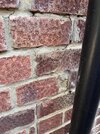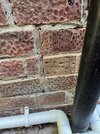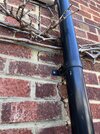Hi there, we have lived in this property for 3 years. 1960s house with a single story extension built in the 80s. We’ve noticed these cracks where the extension joins the main house and are very concerned. They were not mentioned in our full structural survey. Can anyone advise on what our next steps should be. Many thanks!
-
 Looking for a smarter way to manage your heating this winter? We’ve been testing the new Aqara Radiator Thermostat W600 to see how quiet, accurate and easy it is to use around the home. Click here read our review.
Looking for a smarter way to manage your heating this winter? We’ve been testing the new Aqara Radiator Thermostat W600 to see how quiet, accurate and easy it is to use around the home. Click here read our review.
You are using an out of date browser. It may not display this or other websites correctly.
You should upgrade or use an alternative browser.
You should upgrade or use an alternative browser.
Is my house subsiding
- Thread starter LorEm
- Start date
Looks like you have an extension toothed into an existing structure. Also looks like the crack is slightly wider at the top than at the bottom.
There is a possibility that it could indicate rotational movement of the extension foundations.
Have you noticed the crack change in size recently or over a more extended period of time?
Do you have clay soils? Any trees nearby, particularly large mature ones, or possibly smaller ones in close proximity?
We haven't had much rain lately and the trees will still be extracting water from the soil throughout the summer period.
You can monitor the crack using monitoring studs and vernier callipers to determine if the movement is ongoing.
You can also dig a trial pit and check foundation depths, and get the soil tested along with analysis of any tree roots within close proximity of the foundation...
There is a possibility that it could indicate rotational movement of the extension foundations.
Have you noticed the crack change in size recently or over a more extended period of time?
Do you have clay soils? Any trees nearby, particularly large mature ones, or possibly smaller ones in close proximity?
We haven't had much rain lately and the trees will still be extracting water from the soil throughout the summer period.
You can monitor the crack using monitoring studs and vernier callipers to determine if the movement is ongoing.
You can also dig a trial pit and check foundation depths, and get the soil tested along with analysis of any tree roots within close proximity of the foundation...
Thank you for your reply. Next door have a tree very close to our extension, less than 1m away, it’s quite high- taller than the house. We are I. The south east, I’m not sure what soil type we have! I can’t remember ever noticing the crack and it didn’t get flagged in our survey!
They should employ a structural engineer to test, monitor, and report on the findings as I suggested above.We’ve called our insurance company and they are coming out to assess. We feel physically sick that this is a major problem and will cost us thousands.
How long has the tree been there? Does the extension predate the tree? If so there’s a good chance the foundations aren’t deep enough for the influence of the tree roots.
If it turns out you are on clay it would be worth asking your neighbour nicely to remove the tree. Given time the clay will rehydrate and the crack will close back up.
Underpinning is a last resort and the insurance company will do all they can to avoid paying out for it. It’s not what you want either.
Thank you both. My husband seems to think we are on clay and we also have a hosepipe ban currently, due to the extensive dry weather so I wouldn’t be surprised if this was a contributing factor.
We are unsure how long the tree has been there but the extension was built in the 80s. We just hope the insurance company won’t leave us high and dry. It’s such a concerning time. Everything seems level in the extension: door frames, floors etc.
So am I to understand that when the ground rehydrates the crack will resolve? Is this the same as subsidence?
We are unsure how long the tree has been there but the extension was built in the 80s. We just hope the insurance company won’t leave us high and dry. It’s such a concerning time. Everything seems level in the extension: door frames, floors etc.
So am I to understand that when the ground rehydrates the crack will resolve? Is this the same as subsidence?
To me it looks more like bad toothing in that has cracked over time.
There shouldn't be 3 rows of bricks lined up.
They would've been better off with wall starters if they didn't know how to do it.
There shouldn't be 3 rows of bricks lined up.
They would've been better off with wall starters if they didn't know how to do it.
If this is poor workmanship then I’m guessing the insurance will not pay out. I think this will be a steep learning curve for us and a very expensive one.
Is the crack larger at the top than the bottom? If it is it indicates rotation of the foundation. If not, it's probably just shrinkage at the joint.
At the moment the crack looks minor and the insurance company at best will arrange for an engineer to report on the cracking.
However, you will probably have an excess to pay so it'll come out of your pocket.
If it's just poor workmanship it's really nothing to be concerned about. You could tie the walls together with some helical bar but that shouldn't work out particularly expensive.
We’ve just found out that the neighbours tree is an ash and approx 1m from our extension. A quick Google search has told me that these trees should not be this close. I wonder if this is causing the problem.
How long has the tree been there?
Does the extension predate the tree? If so there’s a good chance the foundations aren’t deep enough for the influence of the tree roots.
If it turns out you are on clay it would be worth asking your neighbour nicely to remove the tree. Given time the clay will rehydrate and the crack will close back up.
Underpinning is a last resort and the insurance company will do all they can to avoid paying out for it. It’s not what you want either.
Also, how tall is the tree? Is it mature? If you have clay soils and the extension predates the tree, your best bet is to ask your neighbour to remove it, regardless of whether the cracking is indicative of subsidence. Otherwise the risk is always there.
Last edited:
- Joined
- 1 May 2018
- Messages
- 2,218
- Reaction score
- 742
- Country

Certainly an ash tree shouldn't be 1m from the extension on clay. I would get the insurance co involved, but you might also, if you have legal expenses insurance with your house, have a chat to them about the tree and potential issues and see what they say. It may be a long road, and the tree may have a TPO, but ideally the tree should probably be removed. However, there is the caveat that removing a tree can cause "heave" - the opposite of subsidence. You may well need input from a tree expert.
Don't rush - take it a step at a time - do you get on with the neighbours? how close is the tree to their house? Big trees - ash, oak, lime, sycamore etc really should not be very close to buildings. It would be better to solve the problem through cooperation and dialogue, but if that isn't possible, potentially it could go legal.
Don't rush - take it a step at a time - do you get on with the neighbours? how close is the tree to their house? Big trees - ash, oak, lime, sycamore etc really should not be very close to buildings. It would be better to solve the problem through cooperation and dialogue, but if that isn't possible, potentially it could go legal.
DIYnot Local
Staff member
If you need to find a tradesperson to get your job done, please try our local search below, or if you are doing it yourself you can find suppliers local to you.
Select the supplier or trade you require, enter your location to begin your search.
Please select a service and enter a location to continue...
Are you a trade or supplier? You can create your listing free at DIYnot Local
Similar threads
- Replies
- 34
- Views
- 19K
- Replies
- 6
- Views
- 13K



